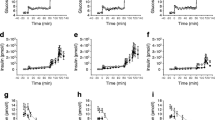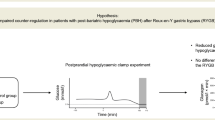Abstract
Objective
To examine the release of counterregulatory hormones and consecutive glimepiride serum concentrations during severe hypoglycaemia (SH) associated with glimepiride therapy.
Methods
In nine type-2 diabetic patients [age 81±9 (65–93) years; diabetes duration 9±4 (3–15) years; initial blood glucose 33±16 (10–54) mg/dl (1.8±0.9 mmol/l); HbA1c 7.2±1.1 (5.6–8.7)%; creatinine clearance 49±33 (15–107) ml/min] who experienced SH associated with glimepiride therapy with neuroglucopenic presentation, insulin, C-peptide, glucagon, epinephrine, norepinephrine, cortisol, adenocorticotrophic hormone (ACTH), human growth hormone (HGH) and pancreatic polypeptide (PP) were determined in blood samples taken at 4-h intervals prior to and during treatment with glucose i.v. Serum from the same samples was screened for sulphonylurea-type oral antidiabetics. Glimepiride concentrations were determined by a validated atmospheric pressure chemical ionization liquid chromatographic-mass spectrometry (APCI-LC-MS) assay.
Results
Once treatment had begun, normoglycaemia was maintained; most glimepiride levels were below the limit of detection (LOD <0.01 mg/l) and further sulphonylureas could be excluded. The secretion of glucagon and epinephrine as counterregulatory hormonal responses was unaffected. In addition, protracted marked increases of cortisol and norepinephrine levels were demonstrated. Protracted stimulation of insulin and C-peptide occurred in a period of up to 24 h after SH. No significant protracted responses were observed for ACTH, HGH or PP.
Conclusion
In SH associated with glimepiride therapy, no correlation between glimepiride serum concentrations and the protracted stimulation of insulin and C-peptide was observed. The secretion of glucagon and epinephrine as counterregulatory hormonal responses was unaffected. Protracted increased release of cortisol might be a medium-term indicator of glimepiride-associated SH.

Similar content being viewed by others
References
Sugarman JR (1991) Hypoglycemia associated hospitalizations in a population with a high prevalence of non-insulin-dependent diabetes mellitus. Diab Res Clin Pract 14:139–148
Bachmann W, Löbe A, Lacher F (1995) Medikamentös bedingte Hypoglykämien bei Typ-II-Diabetes. Diabetes und Stoffwechsel 4:83–89
Asplund K, Wiholm B-E, Lithner F (1983) Glibenclamide-associated hypoglycaemia: a report on 57 cases. Diabetologia 24:412–417
Holstein A, Plaschke A, Egberts E-H (2001) Lower incidence of severe hypoglycaemia in type 2 diabetic patients treated with glimepiride versus glibenclamide. Diab Metabol Res Rev 17:467–473
Holstein A, Plaschke A, Hammer C, Egberts E-H (2003) Characteristics and time course of severe glimepiride- versus glibenclamide induced hypoglycaemia. Eur J Clin Pharmacol 59:91–97
Stahl M, Berger W (1999) Higher incidence of severe hypoglycaemia leading to hospital admission in type 2 diabetic patients treated with long-acting versus short-acting sulphonylureas. Diabet Med 16:586–590
Spyer G, Hattersley AT, MacDonald IA, Amiel S, MacLeod KM (2000) Hypoglycaemic counter-regulation at normal blood glucose concentrations in patients with well controlled type-2 diabetes. Lancet 356:1970–1974
Meneilly GS, Cheung E, Tuokko H (1994) Counterregulatory hormone responses to hypoglycemia in the elderly patient with diabetes. Diabetes 43:4403–4409
Holstein A, Plaschke A, Vogel Y-M, Egberts E-H (2003) Prehospital management of diabetic emergencies—a population-based intervention study. Acta Anaesthesiol Scand 47:610–615
Sills MN, Ogu CC, Maxa J (1997) Prolonged hypoglycemic crisis associated with glyburide. Pharmacotherapy 17:1338–1340
Krepinsky J, Ingram AJ, Clase CM (2000) Prolonged sulfonylurea-induced hypoglycemia in diabetic patients with end-stage renal disease. Am J Kidney Dis 35:500–505
Cockroft DW, Gault MH (1976) Prediction of creatinine clearance from serum creatinine. Nephron 16:31–41
Maurer HH, Kratzsch C, Kraemer T, Peters FT, Weber AA (2002). Screening, library-assisted identification and validated quantification of oral antidiabetics of the sulfonylurea-type in plasma by atmospheric pressure chemical ionization liquid chromatography-mass spectrometry. J Chromatogr B 773:63–73
Strachan MW, Abraha HD, Sherwood RA, Lammie GA, Deary IJ, Ewing FM, Perros P, Frier BM (1999) Evaluation of serum markers of neuronal damage following severe hypoglycaemia in adults with insulin-treated diabetes mellitus. Diabetes Metab Res Rev 15:5-12
McAulay V, Deary IJ, Frier BM (2001) Symptoms of hypoglycaemia in people with diabetes. Diabet Med 18:690–705
Heller SR, Macdonald IA, Tattersall RB (1987) Counterregulation in Type II (non-insulin-dependent) diabetes mellitus. Normal endocrine and glycaemic responses, up to ten years after diagnosis. Diabetologia 30:924–929
Peacey SR, George E, Rostami-Hodjegan A, Bedford C, Harris N, Hardisty CA, Tucker GT, Macdonald IA, Heller SR (1996) Similar physiological and symptomatic responses to sulphonylurea and insulin induced hypoglycaemia in normal subjects. Diabet Med 13:634–641
Shamoon H, Friedman S, Canton C, Zacharowicz L, Hu M, Rossettti L (1994) Increased epinephrine and skeletal muscle responses to hypoglycemia in non-insulin-dependent diabetes mellitus. J Clin Invest 93:2562–2571
Landstedt-Hallin L, Adamson U, Lins PE (1999) Oral glibenclamide suppresses glucagon secretion during insulin-induced hypoglycemia in patients with type 2 diabetes. J Clin Endocrinol Metab 84:3140–3145
Segel SA, Paramore DS, Cryer PE (2002) Hypoglycemia-associated autonomic failure in advanced type 2 diabetes. Diabetes 51:724–733
Harrigan RA, Nathan MS, Beattie P (2001) Oral agents for the treatment of type 2 diabetes mellitus: pharmacology, toxicity, and treatment. Ann Emerg Med 38:68–78
Rydberg T, Wahlin-Boll E, Melander A (1991) Determination of glibenclamide and ist two major metabolites in human serum and urine by column liquid chromatography. Chromatography 564:223–233
Badian M, Korn A, Lehr K-H, Malerczyk V, Waldhäusl W (1996) Pharmacokinetics and pharmacodynamics of the hydroxy-metabolite of glimepiride (Amaryl) after intravenous administration. Drug Metab Drug Interact 13:69–85
Kirchheiner J, Brockmöller J, Meineke I, Bauer S, Rohde W, Meisel C, Roots I (2002) Impact of CYP2C9 amino acid polymorphisms on glyburide kinetics and on the insulin and glucose response in healthy volunteers. Clin Pharmacol Ther 71:286–296
Schwanstecher M, Sieverding C, Dorschner H, Gross I, Aguilar-Bryan L, Schwanstecher C, Bryan J (1998) Potassium channel openers require ATP to bind to and act through sulfonylurea receptors. EMBO J 17:5529–5535
Dorschner H, Brekardin E, Uhde I, Schwanstecher C, Schwanstecher M (1999) Stoichometry of sulfonylurea-induced ATP-sensitive potassium channel closure. Mol Pharmacol 55:1060–1066
Song DK, Ashcroft FM (2001) Glimepiride block of cloned beta-cell, cardiac and smooth muscle K(ATP) channels. Br J Pharmacol 133:193–199
Müller G, Hartz D, Pünter J, Ökonomopulos R, Kramer W (1994) Differential interaction of glimepiride and glibenclamide with the β-cell-sulfonylurea receptor. I. Binding characteristics. Biochim Biophys Acta 1191:267–277
Kramer W, Müller G, Geisen K (1996) Characterization of the molecular mode of action of the sulfonylurea, glimepiride, at β-cells. Horm Metab Res 28:464–468
Balant L, Zahnd GR, Weber F, Fabre J (1977) Behaviour of glibenclamide on repeated administration to diabetic patients. Eur J Clin Pharmacol 11:19–25
Hellman B, Schlin J, Täljedal IB (1984) Glibenclamide is exceptional among in hypoglycaemic sulphonylureas in accumulating progressively in β-cell-rich islets. Acta Endocr 105:385–390
Melander A, Donelly R, Rydberg T (1998) Is there a concentration-effect relationship for sulphonylureas? Clin Pharmacokinet 34:181–188
Kwong PY, Teale JD (2002) Screening for sulphonylureas in the investigation of hypoglycaemia. J Roy Soc Med 95:381–385
Author information
Authors and Affiliations
Corresponding author
Rights and permissions
About this article
Cite this article
Holstein, A., Plaschke, A., Hammer, C. et al. Hormonal counterregulation and consecutive glimepiride serum concentrations during severe hypoglycaemia associated with glimepiride therapy. Eur J Clin Pharmacol 59, 747–754 (2003). https://doi.org/10.1007/s00228-003-0697-9
Received:
Accepted:
Published:
Issue Date:
DOI: https://doi.org/10.1007/s00228-003-0697-9




